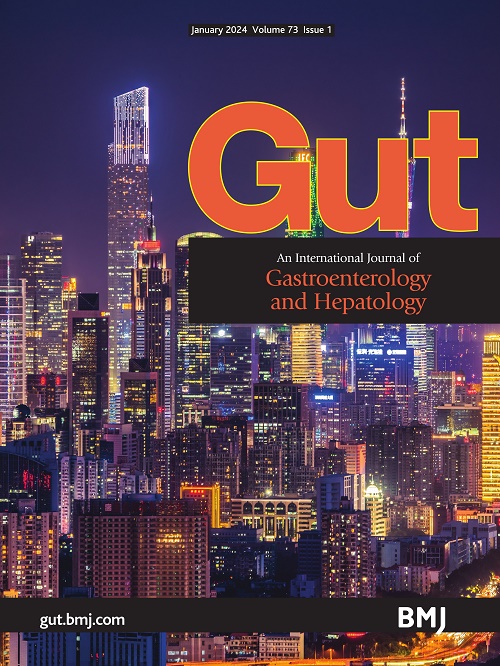Endoscopic papillectomy versus surgical ampullectomy for adenomas and early cancers of the papilla: a retrospective Pancreas2000/European Pancreatic Club analysis
IF 23
1区 医学
Q1 GASTROENTEROLOGY & HEPATOLOGY
引用次数: 0
Abstract
Objective Ampullary neoplastic lesions can be resected by endoscopic papillectomy (EP) or transduodenal surgical ampullectomy (TSA) while pancreaticoduodenectomy is reserved for more advanced lesions. We present the largest retrospective comparative study analysing EP and TSA. Design Of all patients in the database, lesions with prior interventions, benign histology advanced malignancy (T2 and more), patients with hereditary syndromes and those undergoing pancreatoduodenectomy were excluded. All remaining cases as well as a subgroup of them, after propensity-score matching (nearest-neighbour-method) based on age, gender, anthropometrics, comorbidities, size and histological subtype, were analysed. The median follow-up was 21 months (IQR 10–47) after the primary intervention. Primary outcomes were rates of complete resection (R0) and complications. Groups were compared by Fisher’s exact or χ2 test, Mann-Whitney-U-test and log-rank test for survival. Results Of 1673 patients in the database, 1422 underwent EP and 251 TSA. Of them, 23.2% were excluded for missing or inconclusive data and 19.8% of patients for prior interventions or hereditary syndromes. Final histology showed in 24.2% of EP and 14.8% of TSA patients a histology other than adenoma or adenocarcinoma while advanced cancers were recorded in 10.9% of EP and 36.6% of TSA patients. Finally, 569 EP and 63 TSA were included in the overall analysis, with a higher rate of more advanced cases and higher R0 resection rates in the TSA groups (90.5% vs 73.1%; p<0.01), with additional ablation in the EP group in 14.4%. Severe adverse event rates were 3.2% (TSA) vs 1.9% (EP). Recurrence after histological R0 resection was 16% (EP) vs 3.2% (TSA; p=0.01), and additional therapy for R1 resection was applied in 67% of the 159 cases. Propensity-score-based matching identified 62 pairs of EP/TSA patients with comparable baseline patient and lesion characteristics. The initial R0-rate was 72.6% (EP) compared with 90.3% (TSA, p=0.02) with recurrences found in 8% (EP) vs 3.2% (TSA; p=0.07); reinterventions were more frequent in the EP group. Overall survival was comparable. Conclusions The rate of patients with poor indications due to non-neoplastic disease or advanced cancer is still high for both EP and TSA; multiple retreatments were necessary for EP. Although EP can be considered an appropriate primary therapy for certain ampullary adenomas, case selection for both therapies (especially with regard to the best step-up approach) should be studied further. Data are available on reasonable request. All data relevant to the study are included in the article or uploaded as online supplemental information.内镜下乳头切除术与手术壶胃切除术治疗腺瘤和早期乳头癌:一项回顾性胰腺研究2000/欧洲胰腺俱乐部分析
目的壶腹部肿瘤可以通过内镜下乳头切除术(EP)或经十二指肠手术壶腹切除术(TSA)切除,而胰十二指肠切除术则适用于更晚期的病变。我们提出了最大的回顾性比较研究,分析EP和TSA。数据库中所有患者均排除既往干预过的病变、组织学为良性的晚期恶性肿瘤(T2及以上)、有遗传性综合征的患者和行胰十二指肠切除术的患者。在基于年龄、性别、人体测量学、合并症、体型和组织学亚型的倾向评分匹配(最近邻法)后,对所有剩余病例及其亚组进行分析。初次干预后中位随访时间为21个月(IQR 10-47)。主要结果是完全切除率(R0)和并发症。各组间比较采用Fisher精确或χ2检验、mann - whitney - u检验和log-rank生存检验。结果在1673例患者中,1422例接受了EP, 251例接受了TSA。其中,23.2%的患者因数据缺失或不确定而被排除,19.8%的患者因既往干预或遗传综合征而被排除。24.2%的EP患者和14.8%的TSA患者的最终组织学为非腺瘤或腺癌,10.9%的EP患者和36.6%的TSA患者的最终组织学为晚期癌症。最终,569例EP和63例TSA被纳入整体分析,TSA组的晚期病例率和R0切除率更高(90.5% vs 73.1%;p<0.01), EP组追加消融占14.4%。严重不良事件发生率分别为3.2% (TSA)和1.9% (EP)。组织学R0切除后复发率为16% (EP) vs 3.2% (TSA;p=0.01),在159例患者中,有67%的患者接受了R1切除的附加治疗。基于倾向评分的匹配确定了62对EP/TSA患者,其基线患者和病变特征具有可比性。初始r0率为72.6% (EP)和90.3% (TSA, p=0.02),复发率分别为8% (EP)和3.2% (TSA);p = 0.07);再干预在EP组更为频繁。总生存率比较。结论EP和TSA患者因非肿瘤性疾病或晚期癌症导致适应症不佳的比例仍然较高;EP需要多次治疗。虽然对于某些壶腹腺瘤,EP可以被认为是一种合适的主要治疗方法,但两种治疗方法的病例选择(特别是关于最佳的升级方法)应该进一步研究。如有合理要求,可提供资料。所有与研究相关的数据都包含在文章中或作为在线补充信息上传。
本文章由计算机程序翻译,如有差异,请以英文原文为准。
求助全文
约1分钟内获得全文
求助全文
来源期刊

Gut
医学-胃肠肝病学
CiteScore
45.70
自引率
2.40%
发文量
284
审稿时长
1.5 months
期刊介绍:
Gut is a renowned international journal specializing in gastroenterology and hepatology, known for its high-quality clinical research covering the alimentary tract, liver, biliary tree, and pancreas. It offers authoritative and current coverage across all aspects of gastroenterology and hepatology, featuring articles on emerging disease mechanisms and innovative diagnostic and therapeutic approaches authored by leading experts.
As the flagship journal of BMJ's gastroenterology portfolio, Gut is accompanied by two companion journals: Frontline Gastroenterology, focusing on education and practice-oriented papers, and BMJ Open Gastroenterology for open access original research.
 求助内容:
求助内容: 应助结果提醒方式:
应助结果提醒方式:


